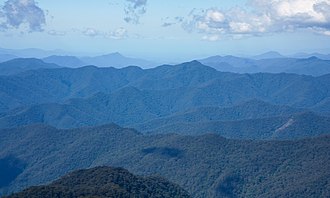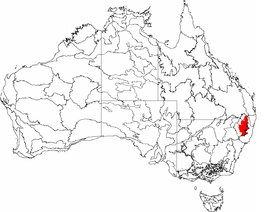| New England Tablelands Australia | |||||||||||||||
|---|---|---|---|---|---|---|---|---|---|---|---|---|---|---|---|
 View west over the New England Tablelands from Point Lookout. | |||||||||||||||
 The interim Australian bioregions, with New England Tablelands in red. | |||||||||||||||
| Elevation | 600–1,500 m (1,969–4,921 ft)[1] | ||||||||||||||
| Area | 30,022 km2 (11,591.6 sq mi)[2] | ||||||||||||||
| |||||||||||||||
| |||||||||||||||
New England Tablelands (code NET), an interim Australian bioregion, is located mainly in New South Wales,[4][5] comprising 3,002,213 hectares (7,418,630 acres),[2] of which 2,860,758 hectares (7,069,090 acres) or 95.23 per cent of the bioregion lies within New South Wales; and the residual within Queensland. This bioregion is one of the smaller bioregions in NSW, occupying 3.57 per cent of the state.[6]
The New England Tableland Bioregion is a stepped plateau of hills and plains with elevations between 600 and 1,500 metres (2,000 and 4,900 ft) on Permian sedimentary rocks, intrusive granites and extensive Tertiary basalts.[1] Rainfall varies considerably from 653 to 1,765 millimetres (25.7 to 69.5 in)[3] and mean temperatures range from −3 to 17 °C (27 to 63 °F),[3] based on changes with topography. In terms of plants, the region is dominated by stringy bark/box/peppermint species, including Eucalyptus caliginosa, E. nova-anglica, E. melliodora and E. blakelyi.[7]
- ^ a b "New England Tableland - landform". Office of Environment & Heritage. Government of New South Wales. 26 April 2016. Retrieved 25 March 2018.
- ^ a b "Interim Biogeographic Regionalisation for Australia (IBRA7) regions and codes". Department of Sustainability, Environment, Water, Population and Communities. Commonwealth of Australia. 2012. Retrieved 13 January 2013.
- ^ a b c d e "New England Tableland - climate". Office of Environment & Heritage. Government of New South Wales. 26 April 2016. Retrieved 25 March 2018.
- ^ Environment Australia. "Revision of the Interim Biogeographic Regionalisation for Australia (IBRA) and Development of Version 5.1 - Summary Report". Department of the Environment and Water Resources, Australian Government. Archived from the original on 5 September 2006. Retrieved 31 January 2007.
- ^ IBRA Version 6.1 data
- ^ "New England Tableland Bioregion". Office of Environment & Heritage. Government of New South Wales. 26 April 2016. Retrieved 25 March 2018.
- ^ Cite error: The named reference
IBRA 5.1addwas invoked but never defined (see the help page).